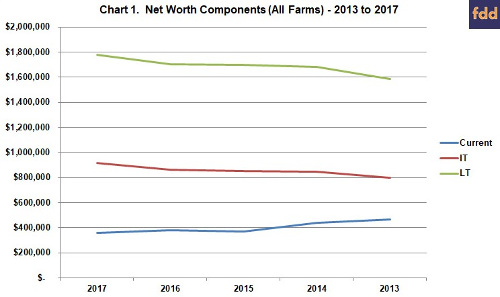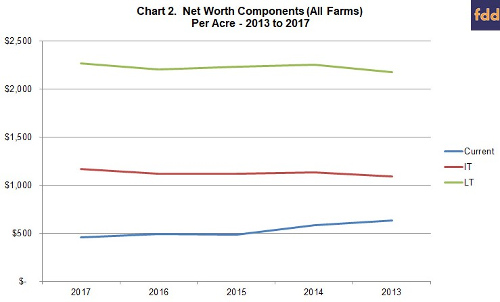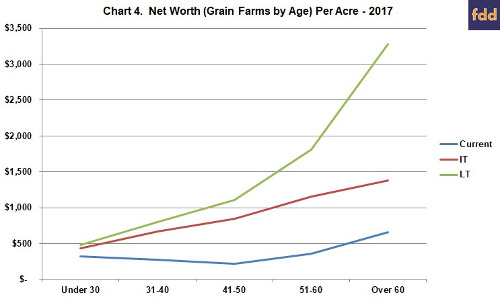By Bradley Zwilling, Brandy Biros, and Dwight Raab
Illinois FBFM and Department of Agricultural and Consumer Economics
University of Illinois
The March 15, 2019 farmdoc daily reviewed ‘Accumulating Liabilities’ in the balance sheet of a group of observations in the Illinois FBFM Association dataset from 2013 to 2017. The May 17, 2019 farmdoc daily reviewed ‘Accumulating Assets’ in a similar fashion. This is the third in a series and considers the net worth component of the balance sheet from a current, intermediate and long term perspective. As noted in the earlier two articles, the data behind the charts originates with the Illinois Farm Business Farm Management Association.
Chart 1 depicts the dollar amount of average current, intermediate and long-term net worth from 2013 to 2017. Farms represented in this dataset are predominantly grain farms but include hog, beef and dairy operations. There is a 22.7% decrease in average current net worth or $(104,099) over the five-year period. A 15.0% increase in average intermediate net worth or $119,929 occurs as does a 12.2% increase in long-term net worth or $193,046. The change in percentage terms masks the dollar amount change as long-term net worth is greater than twice the level of current and intermediate term assets. Farm size did increase from an average of 730 tillable acres to 786 tillable acres in the intervening five years with a steady ‘percent owned acres’ which may explain some of the increase in long-term net worth.

Chart 2 depicts the same information as Chart 1 except that it is on a ‘per acre’ basis which normalizes the reported net worth component by the number of acres in the farm. As noted previously, the average number of acres from this five-year span of time runs from a low of 730 acres in 2013 to a high of 786 acres in 2017 – so the range is fairly small. This tells just a bit different story in that there is 27.4% decrease in average current net worth or $178/acre over the five-year period. There is a 6.8% increase in average intermediate net worth or $74/acre and a 4.1% increase in long-term net worth or $90/acre. Both Chart 1 and Chart 2 show a trend to lesser levels of current net worth and increasing levels of intermediate and long-term net worth. Chart 2 shows the changes to be muted when considered on a per acre basis.

Charts 3 and Chart 4 consider grain farms exclusively and as such is a subset of the data used in the first two charts. Charts 3 and 4 use data from only 2017. Further, these two charts segment the three classes of net worth into five age groups.

long-term net worth. Note that long-term net worth increases markedly as operator age increases. Presumably as the result of the accumulation of a lifetime of farm (and possibly off farm earnings) of the farm family. As noted in Chart 1, the dollar level of long-term net worth in general is far greater than that of current or intermediate net worth.

Chart 4 divides the three classes of net worth by the number of acres operated and also segments the data into five age groups. The number of tillable operator acres in each of the age groups is: Under 30 – 434 acres, Age 31 to 40 – 693 acres, Age 41 to 50 – 1007 acres, Age 51 to 60 – 946 acres and Over Age 60 – 711 acres. Current net worth is steady from the Under Age 30 group through the Age 51-60 group and then increases for the remaining age group. Average intermediate term net worth per acre increases at a steady rate through the five age groups. Average long-term net worth increases as a lesser rate in the lower age groups and then increases dramatically into the 51-60 and Over 60 age groups.
Summary. Our Illinois FBFM data indicate a long term trend of intermediate and long-term net worth increases for the period. Current net worth (or working capital) decreases over the five year period. When the components of net worth are considered for 2017 only, it is evident that all three net worth components increase as age increases. This likely due to the many years of farm (and possibly off farm) earnings accumulating in the balance sheet of the operator as they age.
Source: farmdocdaily